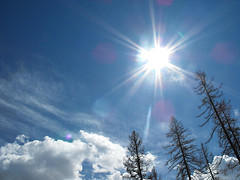Does the kid in you still dream about being an astronaut? If you're still dreaming of walking on the moon, check out these facts from NASA about space suits and walking in space!
1) The temperature in space varies drastically, so it's important that astronauts wear specially designed space suits. The temperature can get as hot as 250 degrees Fahrenheit and just as cold.
2) Without the astronauts in them, a space suit weights 280 pounds on earth, while in space, the suits are weightless. Space suits are custom-made for each astronaut, but there is no difference between male and female suits, except for size.
3) It takes 45 minutes to put on a space suit. Then, an astronaut must wait up to an hour, breathing in pure oxygen, to let the body adjust before going on a space walk.
4) To get used to the weightless feeling of outer space, astronauts practice in their suits in the Neutral Buoyancy Lab, a pool filled with 6.2 million gallons of water.
5) Space walks are called EVA, which stands for extravehicular activity. The first EVA by an American took place in June of 1965. The longest EVA to occur was almost nine hours long!
Visit NASA's website for more information.


![By ESO/S. Guisard (http://www.eso.org/public/images/milky-way-cactus/) [CC-BY-3.0 (http://creativecommons.org/licenses/by/3.0)], via Wikimedia Commons. (From http://upload.wikimedia.org/wikipedia/commons/5/52/Echinopsis_Atacamensis_and_the_Milky_Way_%28wallpaper%29.jpg.) Stars, Milky Way, Galaxy, Planets, Sky, Desert, Night Sky, Cactus.](http://blog.respage.com/provence-at-valencia-apartments/files/2013/12/wpid-4949.jpg)
 Equal Housing Opportunity
Equal Housing Opportunity